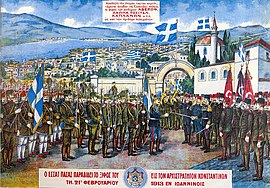Battle of Bizani
| Battle of Bizani | |||||||
|---|---|---|---|---|---|---|---|
| Part of the First Balkan War | |||||||
 The surrender of the Ottoman garrison of Ioannina after the battle |
|||||||
|
|||||||
| Belligerents | |||||||
|
|
|
||||||
| Commanders and leaders | |||||||
| Crown Prince Constantine |
Esat Pasha |
||||||
| Units involved | |||||||
| Army of Epirus | Yanya Corps | ||||||
| Strength | |||||||
| 4 infantry divisions, 1 cavalry brigade and 1 cavalry regiment: 41,000 soldiers 105 guns |
4 infantry divisions: 35,000 soldiers Unknown number of irregulars 162 guns |
||||||
| Casualties and losses | |||||||
| 284 dead and wounded | 2,800 dead | ||||||
The Battle of Bizani took place in Epirus on 4–6 March [O.S. 19–21 February] 1913. The battle was fought between Greek and Ottoman forces during the last stages of the First Balkan War, and revolved around the forts of Bizani, which covered the approaches to Ioannina, the largest city in the region.
At the outbreak of the war, the Greek Army on the Epirus front did not have the numbers to initiate an offensive against the German-designed defensive positions in Bizani. However, after the campaign in Macedonia was over, a large number of Greek troops were redeployed to Epirus, where Crown Prince Constantine himself assumed command. In the battle that followed the Ottoman positions were breached and Ioannina taken. Despite having a slight numerical advantage, this was not the decisive factor in the Greek victory. Rather, "solid operational planning" by the Greeks was key as it helped them implement a well-coordinated and executed assault that did not allow the Ottoman forces time to react.
As the main war effort of Greece was initially turned towards Macedonia, on the Epirus front the Greek army was outnumbered by the Ottoman Yanya Corps at the outbreak of hostilities in October 1912. After stopping an initial attack by the Ottoman commander Esat Pasha at Gribovo, however, the Greeks succeeded in liberating Preveza (October 21) and pushing north in the direction of Ioannina, repulsing an Ottoman attack at Pente Pigadia (Beshpinar). On November 5, a small force from Corfu made a landing and captured the coastal area of Himarë without facing significant resistance, and on December 20 Greek troops improved their positions in Epirus and entered Korçë, north of Ioannina, thus cutting off its last supply route and threatening the city's northeastern flank.
...
Wikipedia
